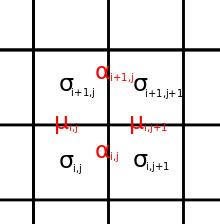 | ||
In statistical mechanics, the eight-vertex model is a generalisation of the ice-type (six-vertex) models; it was discussed by Sutherland, and Fan & Wu, and solved by Baxter in the zero-field case.
Contents
Description
As with the ice-type models, the eight-vertex model is a square lattice model, where each state is a configuration of arrows at a vertex. The allowed vertices have an even number of arrows pointing towards the vertex; these include the six inherited from the ice-type model (1-6), and sinks and sources (7, 8).
We consider a
where the summation is over all allowed configurations of vertices in the lattice. In this general form the partition function remains unsolved.
Solution in the zero-field case
The zero-field case of the model corresponds physically to the absence of external electric fields. Hence, the model remains unchanged under the reversal of all arrows; the states 1 and 2, and 3 and 4, consequently must occur as pairs. The vertices can be assigned arbitrary weights
The solution is based on the observation that rows in transfer matrices commute, for a certain parametrisation of these four Boltzmann weights. This came about as a modification of an alternate solution for the six-vertex model; it makes use of elliptic theta functions.
Commuting transfer matrices
The proof relies on the fact that when
the transfer matrices
for fixed modulus
and
The matrix function Q ( u ) {displaystyle Q(u)}
The other crucial part of the solution is the existence of a nonsingular matrix-valued function
where
The existence and commutation relations of such a function are demonstrated by considering pair propagations through a vertex, and periodicity relations of the theta functions, in a similar way to the six-vertex model.
Explicit solution
The commutation of matrices in (1) allow them to be diagonalised, and thus eigenvalues can be found. The partition function is calculated from the maximal eigenvalue, resulting in a free energy per site of
for
where
Equivalence with an Ising model
There is a natural correspondence between the eight-vertex model, and the Ising model with 2-spin and 4-spin nearest neighbour interactions. The states of this model are spins
The most general form of the energy for this model is
where
We denote horizontal and vertical spins (arrows on edges) in the eight-vertex model
Equating general forms of Boltzmann weights for each vertex
It follows that in the zero-field case of the eight-vertex model, the horizontal and vertical interactions in the corresponding Ising model vanish.
These relations gives the equivalence
